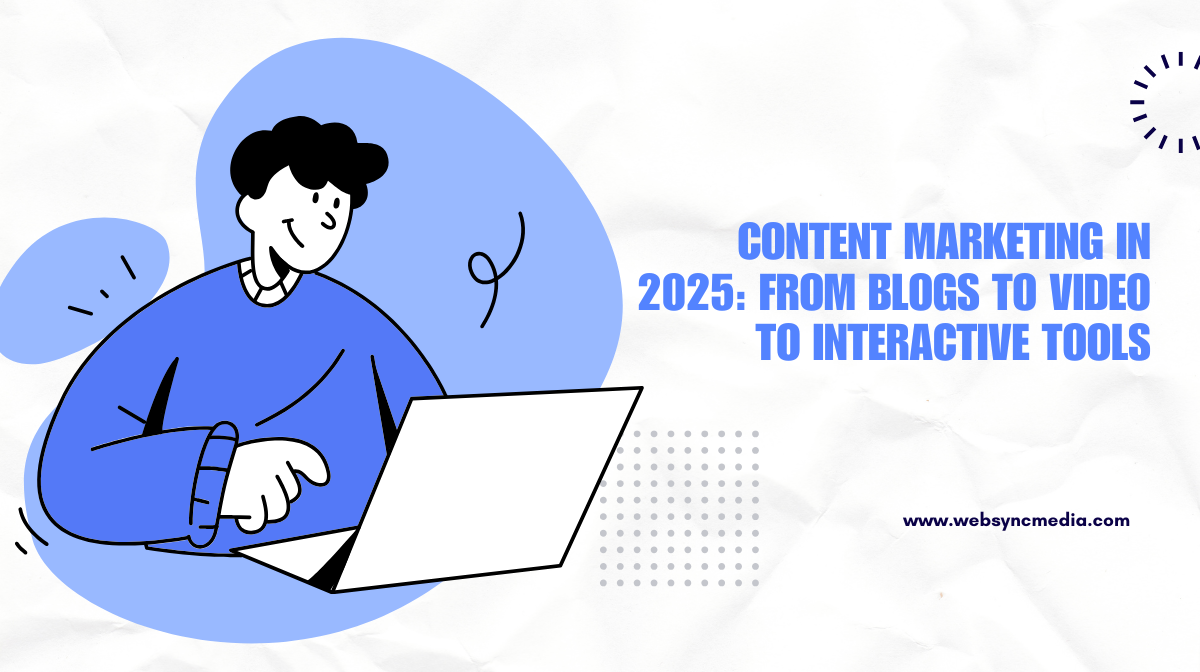In the rapidly changing landscape of digital marketing, content marketing in 2025 has evolved beyond traditional written blogs. The modern audience demands interactive, video-based, and personalized content that delivers real value and fosters engagement. This transformation is fueled by advancements in artificial intelligence (AI), changing audience behavior, and the growing importance of authenticity and community-building.
Content marketing is no longer about publishing in bulk. Instead, it focuses on creating meaningful experiences through a blend of storytelling, visual formats, and interactivity. Let’s explore how businesses can adapt and thrive in this new era.
The Evolution of Content Marketing
A few years ago, content marketing was largely centered on blog posts, SEO optimization, and link-building. While these remain essential, the marketing environment in 2025 is defined by richer experiences, real-time engagement, and AI-enhanced personalization.
Consumers have become more selective. They expect content that speaks directly to their needs, reflects authenticity, and provides instant value. As a result, brands are shifting their strategies from static communication to dynamic engagement through formats like video, podcasts, live sessions, and interactive tools.
Three major changes define this shift:
-
A move from text-heavy content to video-first storytelling.
-
A focus on interactive and community-based content rather than passive consumption.
-
The integration of AI and data-driven personalization to deliver relevant experiences.
Embrace Video: The Future of Engagement
The Rise of Video Content
Video has become the cornerstone of digital marketing. By 2025, video is projected to account for over 82% of all internet traffic. This shift highlights the undeniable influence of visual storytelling in driving engagement, improving SEO performance, and boosting conversions.
Videos capture attention faster than text and are easier to consume on mobile devices, making them ideal for today’s fast-paced audience. Businesses using a mix of short-form and long-form video formats are seeing higher visibility and brand retention.
Key Video Formats for 2025
-
Short-form videos: Bite-sized, 15–60-second clips designed for platforms like TikTok, Instagram Reels, and YouTube Shorts. Perfect for quick tips, trends, and announcements.
-
Long-form videos: Webinars, product demos, or documentaries that explore topics in depth and build brand authority.
-
Live videos: Real-time engagement through Q&A sessions, event streaming, or product launches.
-
Tutorials and explainer videos: Educational videos that solve customer problems or demonstrate product benefits.
Building Engagement Through Storytelling
Modern audiences value authenticity and storytelling over sales-heavy advertising. The best video content showcases real stories, customer experiences, or behind-the-scenes glimpses that create emotional connections.
Encouraging user-generated content (UGC), such as customer reviews or unboxing videos, helps build credibility. UGC also encourages participation and fosters trust by showing genuine experiences.
Prioritize Interactivity and Community
From Passive Consumption to Active Engagement
Static blogs or simple videos are no longer sufficient. The future of content marketing lies in interactive content that involves the audience.
Brands are now using:
-
Polls, surveys, and quizzes to make content more engaging.
-
Interactive infographics that allow users to explore information dynamically.
-
Gamified experiences, such as challenges or competitions, to increase participation.
This shift from passive to active engagement helps brands build stronger emotional bonds and increases content retention rates.
Community Over Traffic
In 2025, the focus has shifted from attracting traffic to building communities. Genuine engagement and long-term relationships matter more than one-time clicks.
Brands are building digital communities through:
-
Private groups or membership-based platforms (such as Discord or Slack).
-
Collaborative content creation, involving followers or influencers.
-
Exclusive content access for loyal users, creating a sense of belonging and value.
Community-driven content strategies help establish loyalty and transform audiences into advocates.
Experiential and Immersive Content
Technology has opened new doors for experiential content through Augmented Reality (AR) and Virtual Reality (VR). These tools make content more immersive, offering unique, real-time experiences.
Examples include:
-
Virtual try-ons for fashion and accessories.
-
360-degree product demos or travel tours.
-
AR filters for interactive social media campaigns.
Such experiences make brands memorable and increase conversion potential.
Leverage AI and Data for Smarter Content Marketing
AI is transforming every aspect of content marketing, from creation to distribution. In 2025, it’s no longer a futuristic concept but a standard practice across industries.
Personalization at Scale
AI helps deliver personalized content experiences that cater to each user’s behavior, preferences, and demographics. By analyzing browsing data, purchase history, and engagement patterns, AI tailors recommendations that feel human and relevant.
This means that two users visiting the same site might see entirely different content—each personalized to their interests and needs.
Efficiency Through Automation
AI tools such as ChatGPT, Jasper, and Copy.ai enable marketers to create, edit, and repurpose content more efficiently.
For example:
-
A single blog can be converted into a series of video scripts.
-
Video transcripts can become social media posts.
-
Data insights can guide the creation of new content topics.
This saves time and resources while maintaining consistent brand messaging across platforms.
Smarter SEO and Optimization
AI-powered SEO tools like Ahrefs, SEMrush, and Clearscope now analyze search intent, trends, and content gaps in real time. This allows marketers to optimize content not only for Google but also for AI-driven search engines and Search Generative Experiences (SGEs).
Key SEO strategies for 2025 include:
-
Using natural, conversational language that aligns with voice search.
-
Adding structured data and schema markup.
-
Creating comprehensive content that satisfies user intent rather than just keywords.
The Content Format Evolution: From Blogs to Multimedia
Blogs Remain Relevant—but in New Ways
Blogs continue to play an important role in 2025, but their purpose has changed. Instead of being the sole content hub, blogs now act as foundational content that fuels other formats.
For instance:
-
A 2,000-word blog can be converted into multiple short videos.
-
Key insights can become carousel posts for LinkedIn or infographics for Instagram.
-
Audio excerpts can be shared as podcasts.
This approach maximizes reach and reinforces key messages across various platforms.
Diversification is Essential
To engage a broader audience, brands must diversify their content strategy. Popular formats in 2025 include:
-
Podcasts: Great for storytelling and thought leadership.
-
Infographics: Ideal for visual learners and quick summaries.
-
Live sessions: Real-time discussions that enhance community connection.
-
Case studies: High-trust content showcasing real results.
-
User-generated content campaigns: Encouraging audience participation.
Each format serves a unique purpose and appeals to different audience segments, creating a complete ecosystem of engagement.
Authenticity as the Core Value
With the growing use of AI-generated content, authenticity has become a defining factor in successful marketing. Audiences can easily detect generic or automated material, which makes human creativity and transparency even more important.
Brands that share genuine stories, demonstrate social responsibility, and highlight their purpose will stand out. Authenticity builds long-term trust and strengthens brand reputation.
The Role of AI in Content Marketing
AI-Powered Creation and Optimization
AI tools have become creative partners for marketers. They assist with idea generation, drafting, proofreading, and even producing visual or video content. However, human oversight remains crucial to ensure quality, tone, and originality.
Hyper-Personalization at Scale
AI helps marketers deliver content experiences tailored to individual users. Examples include:
-
Personalized email campaigns with dynamic product recommendations.
-
Adaptive website content that changes based on user data.
-
Smart chatbots that provide relevant suggestions instantly.
This type of personalization drives stronger engagement and higher conversion rates.
AI in SEO and Analytics
AI-powered analytics platforms continuously track and interpret data. They identify high-performing content, user intent, and trending topics to guide ongoing optimization efforts.
With predictive analytics, marketers can forecast performance and make data-driven adjustments in real time, ensuring every content piece contributes to measurable outcomes.
Core Strategies for Success in 2025
1. Authenticity and Trust
As automated content grows, trust becomes a currency. Brands must focus on human-led, expert-driven, and authentic storytelling to differentiate themselves.
Ways to build trust include:
-
Sharing verified case studies and testimonials.
-
Using employee or customer-generated content.
-
Being transparent about how AI is used in content creation.
2. Omnichannel Distribution
Your content strategy should reach audiences across all digital touchpoints. However, each channel demands a tailored approach:
-
LinkedIn: Professional insights and carousel posts.
-
Instagram/TikTok: Visual storytelling and quick videos.
-
YouTube: Long-form tutorials or brand stories.
-
Websites and emails: In-depth guides and newsletters.
Consistency across channels helps reinforce brand authority while catering to platform-specific user behaviors.
3. Data-Driven Decision Making
Modern content strategies rely on real-time data to shape decisions. Marketers must monitor metrics like engagement, conversion, retention, and SEO performance regularly.
Using AI dashboards and analytics tools allows for continuous improvement and ensures each campaign aligns with business goals.
The Future: Human Creativity Meets AI Intelligence
Content marketing in 2025 represents the perfect blend of technology and human creativity. While AI enhances efficiency and personalization, authentic storytelling remains the heart of meaningful marketing.
Blogs, videos, podcasts, and interactive tools coexist in a unified strategy that prioritizes engagement, value, and trust over sheer volume.
The businesses that will thrive are those that:
-
Combine data with creativity.
-
Blend automation with emotional storytelling.
-
Build communities, not just audiences.
The future of content marketing isn’t about replacing humans with technology—it’s about empowering humans to create richer, more personalized, and impactful experiences for every audience.
- Content Marketing in 2025: From Blogs to Video to Interactive Tools - November 6, 2025
- Instagram vs Pinterest: Where Should a Company Focus for Branding? - October 30, 2025
- How to Choose Between Organic vs Paid Advertising for Your Business - October 22, 2025





